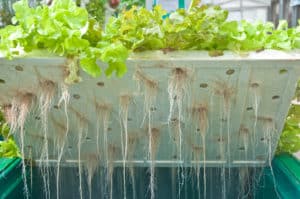Hydroponics is an agriculture method that involves growing plants in something other than soil.
There are a few different approaches to hydroponics. Sometimes the roots are supported in perlite or gravel. Often, however, no growing medium is used; plants are suspended with their roots immersed in the nutrient solution.
The key difference between traditional growing methods and hydroponics is how nutrients are applied to roots. While in traditional agriculture roots receive nutrients via soil, In hydroponics nutrients are supplied to plant roots via mineral nutrient solutions in a water solvent.

flikr.com
What’s in a hydroponic nutrient solution?
Essential nutrients included in the nutrient solution are: Nitrogen, Potassium, Phosphorus, Calcium, Magnesium, and Sulfur.
Additional nutrients that may be included are: Iron, Manganese, Boron, Zinc, and Copper.
Water: Temperature is Critical!
As mentioned above, hydroponics typically involves a plant’s roots being suspended in a water solvent. Because the root of a plant is the start of its vascular system (where nutrients are absorbed), it’s crucial that this area is well cared for. Extreme water temperatures around the root will diminish a plant’s capacity to absorb nutrients and water.

Best Temperature for Hydroponics
To keep plants thriving, the nutrient solution and water solvent must be kept at proper temperatures. Experts agree that the best water solution temperature for hydroponics is between 65°F and 80°F. This temperature range provides an ideal setting for healthy roots and optimal nutrient absorption. To get a bit more technical, when water reservoir temperatures (also known as root zone temperatures) are between 65°F and 80°F, high levels of dissolved oxygen are available at the root zone. Additionally, these ideal temperatures encourage plant disease suppression.
When things get too hot: Cooling Options for Hydroponics
Maintaining ideal water temperatures for your nutrient solution often means incorporating some sort of process cooling solution during hot summer months. Here are a few ideas to help keep things from overheating:

-
Ice Packs
A simple, inexpensive solution is to keep 10-15 ice packs on hand and add one to your reservoir every 15 minutes until the desired temperature is reached. This method may become time-consuming when temperatures are especially high and are likely not a viable option for larger gardens.
-
Cool Water
Another easy solution is to add cool water to your reservoir. Remember that anytime you add water the nutrients will become diluted; check and adjust accordingly.
-
Paint it White!
Painting your reservoir container white will reflect sunlight and heat and help keep your water and nutrient solution cool. This may not keep things quite cool enough when temperatures are especially high, but certainly helps prevent unnecessary heat.
-
Hydroponics Chillers
Chillers are an investment, but for larger operations or serious gardeners, they are the most reliable, effective, and easy to use option. Hydroponic water chillers remove excess heat from your hydroponics system and keep things at a consistent temperature without very much work on your part.
North Slope Chillers are an excellent option for hydroponics cooling. They are easy to install and will not disrupt your current layout. Additionally, North Slope Chillers offers custom solution– no matter what your garden looks like, we can help you keep it cool! Shoot us an email at [email protected] if you’d like more info. We’d love to help you out!

